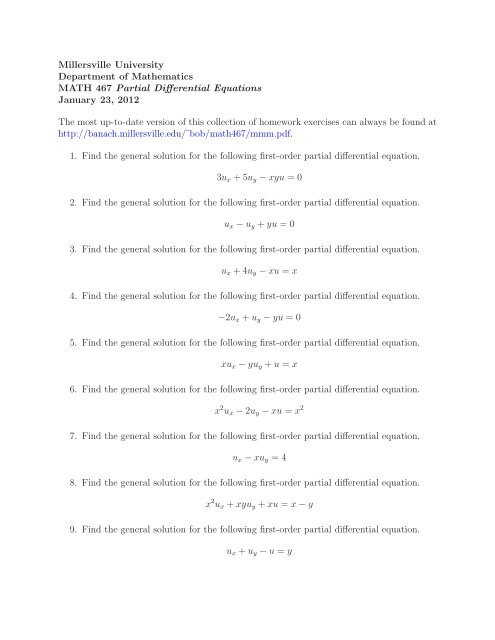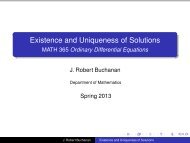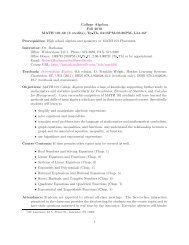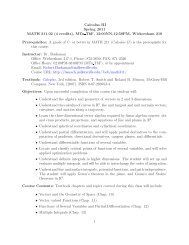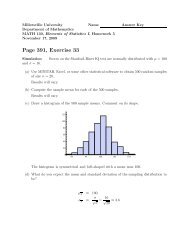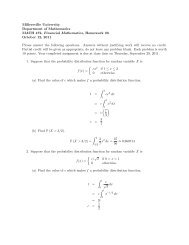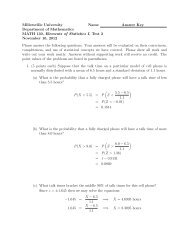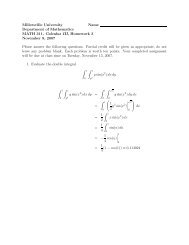MATH 467 Partial Differential Equations Exercises - Millersville ...
MATH 467 Partial Differential Equations Exercises - Millersville ...
MATH 467 Partial Differential Equations Exercises - Millersville ...
You also want an ePaper? Increase the reach of your titles
YUMPU automatically turns print PDFs into web optimized ePapers that Google loves.
<strong>Millersville</strong> University<br />
Department of Mathematics<br />
<strong>MATH</strong> <strong>467</strong> <strong>Partial</strong> <strong>Differential</strong> <strong>Equations</strong><br />
January 23, 2012<br />
The most up-to-date version of this collection of homework exercises can always be found at<br />
http://banach.millersville.edu/˜bob/math<strong>467</strong>/mmm.pdf.<br />
1. Find the general solution for the following first-order partial differential equation.<br />
3ux +5uy −xyu = 0<br />
2. Find the general solution for the following first-order partial differential equation.<br />
ux −uy +yu = 0<br />
3. Find the general solution for the following first-order partial differential equation.<br />
ux +4uy −xu = x<br />
4. Find the general solution for the following first-order partial differential equation.<br />
−2ux +uy −yu = 0<br />
5. Find the general solution for the following first-order partial differential equation.<br />
xux −yuy +u = x<br />
6. Find the general solution for the following first-order partial differential equation.<br />
x 2 ux −2uy −xu = x 2<br />
7. Find the general solution for the following first-order partial differential equation.<br />
ux −xuy = 4<br />
8. Find the general solution for the following first-order partial differential equation.<br />
x 2 ux +xyuy +xu = x−y<br />
9. Find the general solution for the following first-order partial differential equation.<br />
ux +uy −u = y
10. Find the general solution for the following first-order partial differential equation.<br />
ux −y 2 uy −yu = 0<br />
11. Find the general solution for the following first-order partial differential equation.<br />
ux +yuy +xu = 0<br />
12. Find the general solution for the following first-order partial differential equation.<br />
xux +yuy +2 = 0<br />
13. For the following first-order linear partial differential equation find the general solution<br />
and the solutions satisfying the side conditions.<br />
(a) u(x,x) = x 2<br />
(b) u(x,−x) = 1−x 2<br />
3yux−2xuy = 0<br />
(c) u(x,y) = 2x on the ellipse 2x 2 +3y 2 = 4<br />
14. For the following first-order linear partial differential equation find the general solution<br />
and the solutions satisfying the side conditions.<br />
(a) u(x,−6x+2) = e x<br />
(b) u(x,−x 2 ) = 1<br />
(c) u(x,−6x) = −4x<br />
ux −6uy = y<br />
15. For the following first-order linear partial differential equation find the general solution<br />
and the solutions satisfying the side conditions.<br />
(a) u(x,3x) = cosx<br />
(b) u(x,2x) = x<br />
(c) u(x,x 2 ) = 1−x<br />
4ux +8uy −u = 1<br />
16. For the following first-order linear partial differential equation find the general solution<br />
and the solutions satisfying the side conditions.<br />
−4yux +uy −yu = 0
(a) u(x,y) = x 3 on the line x+2y = 3<br />
(b) u(x,y) = −y on y 2 = x<br />
(c) u(1−2y 2 ,y) = 2<br />
17. For the following first-order linear partial differential equation find the general solution<br />
and the solutions satisfying the side conditions.<br />
yux+x 2 uy = xy<br />
(a) u(x,y) = 4x on the curve y = (1/3)x 3/2<br />
(b) u(x,y) = x 3 on curve 3y 2 = 2x 3<br />
(c) u(x,0) = sinx<br />
18. For the following first-order linear partial differential equation find the general solution<br />
and the solutions satisfying the side conditions.<br />
(a) u(x,4x) = x<br />
(b) u(x,y) = −2y on curve y 3 = x 3 −2<br />
(c) u(x,−x) = y 2<br />
y 2 ux +x 2 uy = y 2<br />
19. Show that if u(x,y) = x 2 +y 2 tan −1 (y/x) then<br />
20. Determine the value of n so that<br />
solves the PDE<br />
xux +yuy −u = 0.<br />
u(x,y) = x 3 tan −1<br />
2 2 x −xy +y<br />
x 2 +xy +y 2<br />
xux +yuy −nu = 0.<br />
21. Let F and G be arbitrary differentiable functions and let u(x,y) = F(y/x)+xG(y/x).<br />
Show that u(x,y) solves the PDE<br />
x 2 uxx +2xyuxy +y 2 uyy = 0.<br />
22. Let F, G, and H be arbitrary differentiable functions and let u(x,y) = F(x − y) +<br />
xG(x−y)+x 2 H(x−y). Show that u(x,y) solves the PDE<br />
uxxx +3uxxy +3uxyy +uyyy = 0.
23. The length of a metal rod is not insulated, but instead radiation can take place into<br />
its surroundings. In this case the heat equation takes on the form:<br />
ut = κuxx −c(u−u0)<br />
where u0 is the constant temperature of the surroundings and c is a constant of proportionality.<br />
Show that if we make the change of variable u(x,t)−u0 = v(x,t)e αt where<br />
α is a suitably chosen constant, the equation above can be transformed into the form<br />
of the heat equation for a rod whose length is insulated.<br />
24. The length of a metal rod is not insulated, but instead radiation can take place into<br />
its surroundings. In this case the heat equation takes on the form:<br />
ut = κuxx −c(u−u0)<br />
where u0 is the constant temperature of the surroundings and c is a constant of proportionality.<br />
Suppose u0 = 0, the length of the bar is L = 1, the ends of the bar are<br />
kept at temperature 0, and the initial temperature distribution is given by f(x) for<br />
0 ≤ x ≤ 1. Find u(x,t).<br />
25. Consider the partial differential equation<br />
uxx +uxy +uyy = 0.<br />
(a) Let u(x,y) = f(x)g(y) and use the method of separation of variables to deduce<br />
(b) If f(x)g(y) = 0 verify that<br />
f ′′ (x)g(y)+f ′ (x)g ′ (y)+f(x)g ′′ (y) = 0<br />
− f′′ (x)<br />
f(x) = g′ (y) f<br />
g(y)<br />
′ (x)<br />
f(x) + g′′ (y)<br />
g(y) .<br />
(c) Show that if f′ (x)<br />
f(x) is not constant, then g′ (y)<br />
g(y)<br />
(d) Show that g(y) = Ce λy and show that g′′ (y)<br />
g(y) = λ2 .<br />
is constant, say λ.<br />
(e) Show that f ′′ (x)+λf ′ (x)+λ 2 f(x) = 0. Solve this ODE for f(x) and show that<br />
u(x,y) =<br />
<br />
Acos<br />
<br />
λ √ 3<br />
2 x<br />
<br />
<br />
λ<br />
+Bsin<br />
√ 3<br />
2 x<br />
<br />
e λ(y−x/2)<br />
26. A square plate of edge length a has its planar faces insulated. Three of its edges are<br />
kept at temperature zero while the fourth is kept at constant temperature u0. Show<br />
that the steady-state temperature distribution is given by<br />
u(x,y) = 2u0<br />
π<br />
∞<br />
k=1<br />
(1−coskπ)sin(kπx/a)sinh(kπy/a)<br />
ksinh(kπ)
27. A square plate of edge length a has its planar faces insulated. Three of its edges<br />
are kept at temperature zero while the fourth is kept at temperature f(x). Find the<br />
steady-state temperature distribution in the plate.<br />
28. Find the Fourier Series for f(x) = x 2 on the interval [−L,L].<br />
29. Use the result above to obtain the sums of the following series:<br />
∞ 1<br />
=<br />
k2 k=1<br />
∞ (−1) k+1<br />
k2 =<br />
k=1<br />
∞ 1<br />
=<br />
(2k −1) 2<br />
∞ 1<br />
=<br />
(2k) 2<br />
k=1<br />
30. Let f(x) = (x 2 −1) 2 for −1 ≤ x ≤ 1.<br />
k=1<br />
(a) Find the Fourier Series for f(x) on [−1,1].<br />
(b) What is the minimum number of terms necessary to approximate f(x) by a finite<br />
series to within an error of 10 −4 ?<br />
(c) Use the result above to find the sum of the following series.<br />
31. Assuming that f(x) and f ′ (x) are defined on [−L,L], show that f ′ (x) is an even<br />
function if f(x) is an odd function and f ′ (x) is an odd function if f(x) is an even<br />
function.<br />
32. Find all the real eigenvalues of the following boundary value problem.<br />
∞<br />
k=1<br />
1<br />
k 4<br />
y ′′ +λy = 0 for 0 ≤ x ≤ 1<br />
y(0) = y(1)<br />
y ′ (0) = −y ′ (1)<br />
33. Find all the real eigenvalues of the following boundary value problem.<br />
y ′′ +λy = 0 for 0 ≤ x ≤ π<br />
πy(0) = y(π)<br />
πy ′ (0) = −y ′ (π)
34. For the boundary value problem below, find all the values of L for which there exists<br />
a solution.<br />
y ′′ +y = 0 for 0 ≤ x ≤ L<br />
y(0) = 0<br />
y(L) = 1<br />
35. For the boundary value problem below, show that there are infinitely many positive<br />
eigenvalues {λn} ∞ n=1 where<br />
36. Show that if a /∈ Z that<br />
for −π < x < π.<br />
πcos(ax)<br />
2asin(aπ)<br />
37. For 0 < x < 2π show that<br />
e x = e2π −1<br />
π<br />
38. Use the result above to show that<br />
lim<br />
n→∞ λn = 1<br />
4 (2n−1)2 π 2 .<br />
y ′′ +λy = 0 for 0 ≤ x ≤ 1<br />
y(0) = 0<br />
y(1) = y ′ (1)<br />
1 cosx<br />
= +<br />
2a2 12 cos(2x)<br />
−<br />
−a2 22 cos(3x)<br />
+<br />
−a2 32 −···<br />
−a2 <br />
1<br />
2 +<br />
π cosh(π −x)<br />
·<br />
2 sinhπ<br />
∞<br />
n=1<br />
cos(nx)−nsin(nx)<br />
n2 <br />
.<br />
+1<br />
= 1<br />
2 +<br />
∞<br />
n=1<br />
cos(nx)<br />
n 2 +1 .<br />
39. Use the result above to find the sum of the infinite series<br />
∞ 1<br />
n2 +1 .<br />
n=1<br />
40. Use the result above to find the sum of the infinite series<br />
∞ 1<br />
(n2 +1) 2.<br />
n=1
41. Suppose u(x,t) solves utt = a 2 uxx with a = 0.<br />
(a) Let α, β, x0, and t0 be constants, with α = 0. Show that the function v(x,t) =<br />
u(αx+x0,βt+t0) satisfies<br />
vtt = β2a2 vxx.<br />
α2 (b) Foranyconstantw,let ˆx = cosh(w)x+asinh(w)tandˆt = a −1 sinh(w)x+cosh(w)t.<br />
Show that x = cosh(w)ˆx−asinh(w)ˆt and t = −a −1 sinh(w)ˆx+cosh(w)ˆt.<br />
(c) Define û(ˆx,ˆt) = u(x,t) and show that<br />
utt −a 2 uxx = ûˆtˆt −a 2 ûˆxˆx.<br />
42. Find all the product solutions of the boundary value problem below. Assume k > 0.<br />
utt = a 2 uxx −kut for 0 ≤ x ≤ L, t ≥ 0<br />
u(0,t) = 0<br />
u(L,t) = 0<br />
43. Consider the initial boundary value problem:<br />
utt = a 2 uxx for 0 ≤ x ≤ L, t ≥ 0<br />
u(0,t) = 0<br />
u(L,t) = 0<br />
<br />
πx<br />
<br />
4πx<br />
u(x,0) = 3sin −sin<br />
L L<br />
ut(x,0) = 1<br />
2 sin<br />
<br />
2πx<br />
.<br />
L<br />
Find the Fourier Series solution and the solution according to D’Alembert’s formula<br />
and show that they are equal.<br />
44. Solve the initial boundary value problem:<br />
utt = a 2 uxx for 0 ≤ x ≤ π, t ≥ 0<br />
ux(0,t) = 0<br />
ux(π,t) = 0<br />
u(x,0) = cos 2 x<br />
ut(x,0) = sin 2 x.<br />
45. A string is stretched tightly between x = 0 and x = L. At t = 0 it is struck at the<br />
position x = b where 0 < b < L in such a way that the initial velocity ut is given by<br />
v0 for |x−b| < ǫ<br />
ut(x,0) = 2ǫ<br />
0 for |x−b| ≥ ǫ.
Findthe solution to the wave equation for this initial condition. Discuss the case where<br />
ǫ → 0 + .<br />
46. Define new coordinates in the xy-plane by<br />
ˆx = ax+by +f<br />
ˆy = cx+dy +g<br />
where a, b, c, d, f, and g are constants with ad−bc = 0. Define û(ˆx,ˆy) = u(x,y).<br />
(a) Show that if u is C 2 , then<br />
uxx +uyy = (a 2 +b 2 )ûˆxˆx +2(ac+bd)ûˆxˆy +(c 2 +d 2 )ûˆyˆy.<br />
(b) Suppose that (ˆx,ˆy) are the new coordinates obtained by rotating the original axes<br />
by some angle θ in the counterclockwise direction. Verify that a = cosθ, b = sinθ,<br />
c = −sinθ, and d = cosθ. Show that in this case<br />
47. Solve the boundary value problem<br />
uxx +uyy = ûˆxˆx +ûˆyˆy.<br />
uxx +uyy = 0 for 0 < x < π and 0 < y < π<br />
u(x,0) = sinx<br />
u(x,π) = sinx<br />
u(0,y) = siny<br />
u(π,y) = siny.<br />
48. Find a function of the form U(x,y) = a + bx + cy + dxy such that U(0,0) = 0,<br />
U(1,0) = 1, U(0,1) = −1, and U(1,1) = 2. Use this function to solve the following<br />
boundary value problem.<br />
uxx +uyy = 0 for 0 < x < 1 and 0 < y < 1<br />
u(x,0) = 3sin(πx)+x<br />
u(x,1) = 3x−1<br />
u(0,y) = sin(2πy)−y<br />
u(1,y) = y +1.<br />
49. Solve the boundary value problem<br />
uxx +uyy = 0 for 0 < x < π and 0 < y < π<br />
u(x,0) = 0<br />
u(x,π) = x(π −x)<br />
u(0,y) = 0<br />
u(π,y) = 0.
50. Solve the boundary value problem<br />
uxx +uyy = 0 for 0 < x < π and 0 < y < π<br />
uy(x,0) = cosx−2cos 2 x+1<br />
uy(x,π) = 0<br />
ux(0,y) = 0<br />
ux(π,y) = 0.<br />
51. Find the steady-state temperature distribution for an annulus of inner radius 1 and<br />
outer radius 2 subject to the boundary conditions:<br />
52. Solve the boundary value problem<br />
53. Solve the boundary value problem<br />
u(1,θ) = 3+4cos(2θ)<br />
u(2,θ) = 5sinθ.<br />
uxx +uyy = 0 for x 2 +y 2 < 1<br />
u(1,θ) = −1+8cos 2 θ<br />
u(r,θ+2π) = u(r,θ).<br />
uxx +uyy = 0 for 1 < x 2 +y 2 < 2<br />
u(1,θ) = a<br />
u(2,θ) = b<br />
u(r,θ+2π) = u(r,θ).<br />
54. A flat heating plate is in the shape of a disk of radius 5. The plate is insulated on<br />
the two flat faces. The boundary of the plate is given a temperature distribution of<br />
f(θ) = 10θ 2 where the central angle θ ranges from −π to π. What is the steady-state<br />
temperature at the center of the plate?<br />
55. Let z = a+ib be a complex number (a and b are real numbers and i = √ −1). Show<br />
that<br />
sinz = sin(a)cosh(b)+icos(a)sinh(b).<br />
56. Solve the initial boundary value problem:<br />
ut = 2(uxx +uyy) for 0 ≤ x ≤ 3 and 0 ≤ y ≤ 5<br />
u(x,0,t) = 0<br />
u(x,5,t) = 0<br />
u(0,y,t) = 0<br />
u(3,y,t) = 0<br />
<br />
3πy<br />
u(x,y,0) = cosπ(x+y)−cosπ(x−y)+sin(2πx)sin .<br />
5
57. A solid cube of edge length 1 and with heat diffusivity k is initially at temperature<br />
100 ◦ C. At time t = 0 the cube is placed in anenvironment whose constant temperature<br />
is 0 ◦ C. Find the temperature at the center of the cube as a function of time.<br />
58. A solid cube of edge length 1 and with heat diffusivity k is initially at temperature<br />
100 ◦ C. Five faces of the cube are insulated. At time t = 0 the cube is placed in an<br />
environment whose constant temperature is 0 ◦ C. Find the temperature at the center<br />
of the cube as a function of time.<br />
59. Solve the boundary value problem:<br />
uxx +uyy +uzz = 0 for 0 < x < π, 0 < y < π, 0 < z < π<br />
ux(0,y,z) = 0<br />
ux(π,y,z) = 0<br />
uy(x,0,z) = 0<br />
uy(x,π,z) = 0<br />
uz(x,y,0) = 0<br />
uz(x,y,π) = −1+4sin 2 xcos 2 y.<br />
60. Let f(x,t), g(y,t), and h(z,t) solve the respective heat equations<br />
ft = kfxx<br />
gt = kgyy<br />
ht = khzz.<br />
Show that u(x,y,z,t) = f(x,t)g(y,t)h(z,t) solves the partial differential equation<br />
61. Consider the partial differential equation<br />
ut = k(uxx +uyy +uzz).<br />
uxx +uyy +uzz = 0<br />
on the rectangular solid where 0 ≤ x ≤ L, 0 ≤ y ≤ M, and 0 ≤ z ≤ N. Suppose the<br />
values of u have been specified at the eight corners of the solid. Find a solution of the<br />
form<br />
u(x,y,z) = axyz +bxy +cyz +dxz +ex+fy +gz +h<br />
to the PDE.<br />
62. Consider the partial differential equation<br />
uxx +uyy +uzz = 0
on the solid cube where 0 ≤ x ≤ 1, 0 ≤ y ≤ 1, and 0 ≤ z ≤ 1. Suppose u obeys the<br />
following boundary conditions.<br />
Find a solution of the form<br />
to the boundary value problem.<br />
ux(0,y,z) = a0<br />
ux(1,y,z) = a1<br />
uy(x,0,z) = b0<br />
uy(x,1,z) = b1<br />
uz(x,y,0) = c0<br />
uz(x,y,1) = c1<br />
u(x,y,z) = Ax 2 +By 2 +Cz 2 +Dx+Ey +Fz<br />
63. Convert the function u(x,y,z) = 1/ x 2 +y 2 +z 2 to spherical coordinates and show<br />
that ∆u = 0.<br />
64. Convert the function u(x,y,z) = xyz to spherical coordinates and show that ∆u = 0.<br />
65. Solve the heat equation on the solid sphere of radius 1 with boundary condition<br />
and initial condition<br />
u(1,t) = 0<br />
u(ρ,0) = sin3 (πρ)<br />
.<br />
ρ


